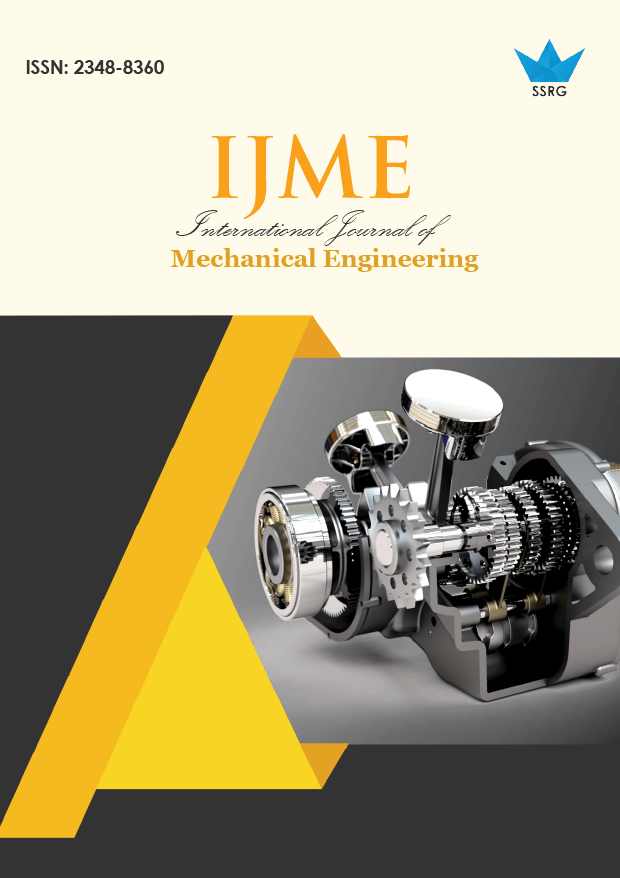Analyses of a Modified SCARA Manipulator (RRRRP) for Pick and Place Application

| International Journal of Mechanical Engineering |
| © 2025 by SSRG - IJME Journal |
| Volume 12 Issue 9 |
| Year of Publication : 2025 |
| Authors : PVS Subhashini, Bharadwaj Aditya Singh |
How to Cite?
PVS Subhashini, Bharadwaj Aditya Singh, "Analyses of a Modified SCARA Manipulator (RRRRP) for Pick and Place Application," SSRG International Journal of Mechanical Engineering, vol. 12, no. 9, pp. 37-45, 2025. Crossref, https://doi.org/10.14445/23488360/IJME-V12I9P104
Abstract:
Selective Compliance Assembly Robot Arm (SCARA) manipulator implementations are effective in the workplace (industrial) world, basically due to their exceptional accuracy and quickness in horizontal task assembly. The only constraint to their functionality is their modulus of vertical motion, which limits their applications with items in warehouse space and in very flexible manufacturing systems, with orientation being highly imperative, where vertical motion is an absolute movement aspect, it can be included. The study employed CAD modelling to engage design contextualization, draft a prototype, structural and kinematic contextualization, and motion contextualization, followed by material selection. This work also included kinematic modelling using the Denavit-Hartenberg method to conceptualize the capture of the workspace, trajectory planning, and finite element analysis of the theoretical concept for stress analysis under loading. A comparison to a traditional SCARA system model showed greater fit with diminished workspace and tolerating mass loads with a greater load capability factor, and it had reasonably significant trajectory planning accuracy. The stress calculations, once sent through the serial chain, confirmed that the system also remained confined to static equilibrium with insignificant displacements of stated loads and totally insignificant deflections that reside in elastic limits. Overall, the ability to realize additional functionality with the proposed product is beneficial both in the workplace by having a greater ability to provide a broader functionality workspace with items that require movement in both planes.
Keywords:
Modified SCARA, CAD modelling, Motion study, Mathematical modelling, 5 DOF, Pick and place operations.
References:
[1] Yasunori Yamazaki, “Development and Applications of the SCARA Robot,” Journal of Robotics and Mechatronics, vol. 26, no. 2, pp. 127-133, 2014.
[CrossRef] [Google Scholar] [Publisher Link]
[2] Morteza Shariateesi et al., “Design of an Economical SCARA Robot for Industrial Applications,” 2014 Second RSI/ISM International Conference on Robotics and Mechatronics (ICRoM), Tehran, Iran, pp. 534-539, 2014.
[CrossRef] [Google Scholar] [Publisher Link]
[3] Sonick Suri et al., “SCARA Industrial Automation Robot,” 2018 International Conference on Power Energy, Environment and Intelligent Control (PEEIC), Greater Noida, India, pp. 173-177, 2018.
[CrossRef] [Google Scholar] [Publisher Link]
[4] Yousif Ismail Mohammed, and Safwan Mawlood Hussein, “Modeling and Simulation of Industrial SCARA Robot Arm,” International Journal of Engineering and Advanced Technology (IJEAT), vol. 4, no. 4, pp. 220-229, 2015.
[Google Scholar] [Publisher Link]
[5] See Han Tay, Wai Heng Choong, and Hou Pin Yoong, “A Review of SCARA Robot Control System,” 2022 IEEE International Conference on Artificial Intelligence in Engineering and Technology (IICAIET), Kota Kinabalu, Malaysia, pp. 1-6, 2022.
[CrossRef] [Google Scholar] [Publisher Link]
[6] Devendra P. Garg, “Adaptive Control of Nonlinear Dynamic SCARA Type of Manipulators,” Robotica, vol. 9, no. 3, pp. 319-326, 1991.
[CrossRef] [Google Scholar] [Publisher Link]
[7] M.C. Lee et al., “Implementation of a New Sliding Mode Control for SCARA Robot,” Proceedings of 1995 American Control Conference - ACC'95, Seattle, WA, USA, pp. 1387-1391, 1995.
[CrossRef] [Google Scholar] [Publisher Link]
[8] Rania Bouzid, Jyotindra Narayan, and Hassène Gritli, “Artificial Neural Networks for the Forward Kinematics of a SCARA Manipulator: A Comparative Study with Two Datasets,” 2024 ASU International Conference in Emerging Technologies for Sustainability and Intelligent Systems (ICETSIS), Manama, Bahrain, pp. 1792-1797, 2024.
[CrossRef] [Google Scholar] [Publisher Link]
[9] Panchanand Jha, and B.B. Biswal, “A Neural Network Approach for Inverse Kinematic of a SCARA Manipulator,” IAES International Journal of Robotics and Automation (IJRA), vol. 3, no. 1, pp. 52-61, 2014.
[CrossRef] [Google Scholar] [Publisher Link]
[10] R.K. Mittle, and I.J. Nagrath, Robotics and Control, 1st ed., Tata McGraw-Hill, 2003.
[Google Scholar] [Publisher Link]
[11] See Han Tay, Wai Heng Choong, and Hou Pin Yoong, “A Review of SCARA Robot Control System,” 2022 IEEE International Conference on Artificial Intelligence in Engineering and Technology (IICAIET), Kota Kinabalu, Malaysia, pp. 1-6, 2022.
[CrossRef] [Google Scholar] [Publisher Link]
[12] Wang Ning, “Optimized Design of SCARA Robot Large Arm Based on ABAQUS Topology Optimization,” Mechanical Research & Application, vol. 36, no. 6, pp. 8-11, 2023.
[CrossRef] [Google Scholar] [Publisher Link]
[13] Baohong Liu, Yongyi He, and Zhipeng Kuang, “Design and Analysis of Dual-Arm SCARA Robot Based on Stereo Simulation and 3D Modeling,” 2018 IEEE International Conference on Information and Automation (ICIA), Wuyishan, China, pp. 1233-1237, 2018.
[CrossRef] [Google Scholar] [Publisher Link]
[14] Xingyu Qiu, “Forward Kinematic and Inverse Kinematic Analysis of A 3-DOF RRR Manipulator,” Proceedings of the 2024 International Conference on Mechanics, Electronics Engineering and Automation, pp. 532-543, 2024.
[CrossRef] [Google Scholar] [Publisher Link]
[15] Yuzhen Chen et al., “Error Modeling and Sensitivity Analysis of a Parallel Robot with SCARA(Selective Compliance Assembly Robot Arm) Motions,” Chinese Journal of Mechanical Engineering, vol. 27, pp. 693-702, 2014.
[CrossRef] [Google Scholar] [Publisher Link]
[16] Aamir Khan et al., “Vision Guided Robotic Inspection for Parts in Manufacturing and Remanufacturing Industry,” Journal of Remanufacturing, vol. 11, pp. 49-70, 2021.
[CrossRef] [Google Scholar] [Publisher Link]

 10.14445/23488360/IJME-V12I9P104
10.14445/23488360/IJME-V12I9P104